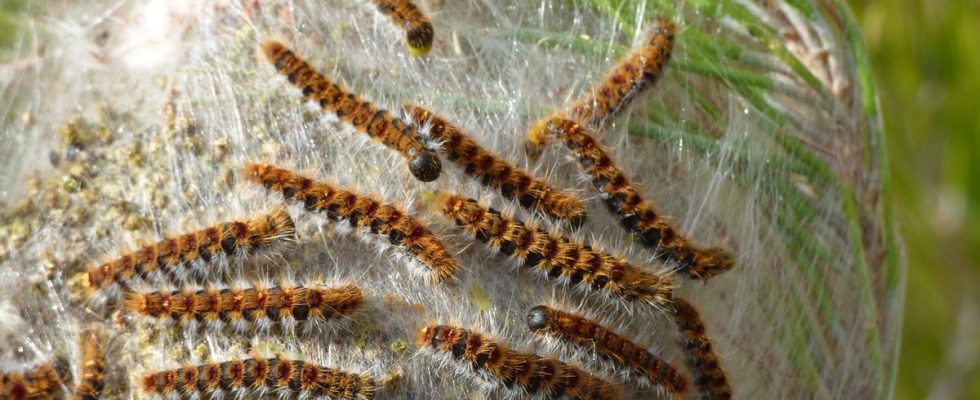They are recognized by their long hair, which gives them a fluffy appearance. And their way of moving in a long Indian file. Like every year in the spring, the processionary caterpillars are back. But do not be fooled by their harmless appearance and keep your distance: before they become butterflies, they are formidable insects, due to their extremely irritating hairs.
Are the risks of encountering them high? What kinds of reactions can they cause? How to protect yourself and how to react in case of contact? 20 minutes explains everything to you.
Where and when do processionary caterpillars occur?
There are two types: “Pine processionary caterpillars, orange-brown, and those of oak, silver-grey, says ANSES. They measure up to 4 cm in length at the end of their growth.
Initially present in the south of France, they have colonized the entire territory thanks to global warming. “The pine processionary caterpillar is present over a very large part of the territory, mainly in the south, center and west of France. It is mainly encountered between January and May, details ANSES. The oak processionary caterpillar is mainly present in the North-East, the Paris region and the North-West of France, and can be present in southern regions. We see it mainly between April and July.
What health risks do they represent?
Processionary caterpillars are covered with “stinging hairs (or bristles), which can cause inflammatory reactions, particularly on the skin, eyes or respiratory tract, sometimes serious in people who are exposed to them”, warns ANSES. “Microscopic” hairs, such as “needles or harpoons, illustrates the health agency. They detach themselves very easily from the body of the caterpillar when it feels threatened”.
And it is not even necessary to be in direct contact with the insect to show symptoms, because “its hairs come off and are transported very easily under the effect of the wind, adds the health agency. Analysis of data from poison control centers showed that in one out of two cases, those exposed had not seen caterpillars. They were exposed to hair deposited by the wind on their clothes, animal fur, gardening equipment or on a terrace”.
This is where scratching lies in wait. “The processionary caterpillars are stinging, just like nettles, recalls Dr. Madeleine Epstein, allergist. It is a non-allergic reaction: 100% of people who will touch a processionary caterpillar will have a reaction, which is manifested by the appearance of small red pimples and itching”. Most of the time, “exposure to stinging silks results in a simple itch accompanied by pimples which disappear after two or three days, abounds the ARS of Hauts-de-France. Sometimes the reaction goes as far as edema. And in some very rare cases, at most 2 to 3% of the population, this exposure can lead to anaphylactic shock, an exacerbated allergic reaction requiring hospitalization. But “it is very infrequent, I have never observed it, and the allergo-vigilance network where we declare all anaphylactic shocks hardly reports any cases, reassures Dr. Epstein. And in our practices, it is not a very frequent reason for consultation”.
The health risk represented by processionary caterpillars was however considered sufficiently serious, since they were added to the list of species whose proliferation is harmful to human health by decree, published in April 2022 At Official newspaper.
Are they dangerous for animals?
They are “the first victims of this contamination (dogs, cats, horses, sheep and cows), answers the ARS of Hauts-de-France. Curious, they will not fail to stick their noses or their tongues on a beautiful procession of caterpillars. The resulting inflammation and swelling of the tongue or oral mucosa can prevent them from feeding or drinking.”
In the most serious cases, “envenomation can go as far as necrosis over the entire oral region, and removal of the tongue is not uncommon in this case, warns the health agency. Many veterinarians have had to sacrifice animals seriously injured by the processionary caterpillar.
How to protect yourself and how to react in case of exposure?
First of all, you should logically “not touch the caterpillars, their nest or the nest-bearing trees and keep children away, recommends ANSES. If you live near infested trees, avoid drying clothes outside and wash picked fruits and vegetables.
In case of contact, the procedure to follow depends on the reaction developed. Thus, “in the event of vital emergency signs (respiratory distress, serious allergic reaction): call 15 or 112”, recommends the Ministry of Health. Or “consult the emergency room”, adds ANSES. “In case of other symptoms (redness, itching), call a poison control center or consult a doctor,” continues the ministry. In case of suspected exposure: take a shower and change your clothes”. And wash them at high temperature to neutralize their toxin.
If the reaction is moderate, “we always prescribe antihistamines, which will relieve the symptoms of hives, says Dr. Epstein. And to soothe the fire of inflammation and itching, you can also put a damp cloth in cold water. If there has been eye contact, in the event of a conjunctival reaction, antihistamine eye drops will provide relief. If it is a reaction in the skin of the eyelids, the eyes are swollen and closed, a systemic antihistamine is recommended”.
To date, recalls ANSES, “there is no single or definitive solution. It is not possible to eradicate these two species” of processionary caterpillars.

